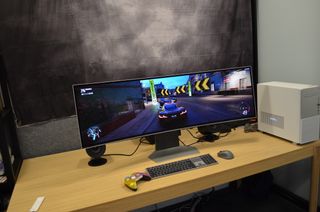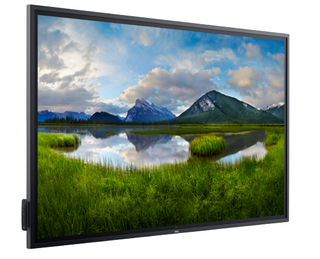Largest computer monitors of 2025
See the bigger picture with the largest computer monitors for your set-up
1. Best overall
2. Best for gaming
3. Best for business
4. FAQs
5. How to choose
6. How we test
The largest computer monitors let you add extra screen real-estate to your set-up, delivering detailed, high-resolution images, crisp colors, and more room to work.
Our team of reviewers have tested out the best ultrawide monitors and best business monitors to find the top big--screen models for content creation, gaming, and office tasks that let you zero in on every detail. While you'll find loads of great displays out there, choosing the largest monitor that's best for you is more about screen size. It's about finding the one that complements your workflow and productivity - and making sure it fits in your home office.
We've reviewed hundreds of displays, from portable screens to massive monitors. We've measured up the top picks, reviewing everything from refresh rates and response times to color accuracy, connectivity, and ports. If you're looking for the largest computer monitor, these are the ones we recommend adding to your set-up.
The largest computer monitors of 2025 in full:
Why you can trust TechRadar
Largest computer monitor: Best overall

Specifications
Reasons to buy
Reasons to avoid
Since our original in-depth review in late 2023 the OLED G9's price has come down from around $2100 to just $1800, making its price much more reasonable for a 49-inch 4K monitor.
The G9 is classified as an ultrawide curved monitor, so in theory is able to juggle multiple workspaces and gaming. In our review we found the best performance was to be had when pairing this monitor with a powerful graphics card such as the RTX 4090.
Gamers in particular will be delighted with the massive 32:9 resolution. During our test, titles like Forza Horizon 5 and Doom: Eternal showed both game detail and user interface in precision detail.
While we're on the topic of UI, for some reason Samsung has overhauled their previous user interface which was clear and easy to use. The updated version is extremely clunky and makes it difficult to access new features. We hope this will be fixed with a firmware update in future. But while it may not be the de facto biggest computer monitor, it’s an excellent choice for those who want more screen real estate.
Read our full Samsung Odyssey OLED G9 review .
Largest computer monitor: Best for gaming

Specifications
Reasons to buy
Reasons to avoid
Samsung has had great success with its ever growing range of ultrawide curved gaming monitors, so it’s perhaps not surprising that the company has decided to take a risk on a TV-sized computer monitor with a 16:9 ratio.
As one of the largest computer monitors, it comes with one of the coolest accessories we've ever reviewed. Besides the regular infra-red remote, there’s a Bluetooth 'Ark Dial'. This remote uses buttons and a large notched scroll wheel to make adjusting gaming and picture settings easier to navigate.
On the flipside, this particular monitor cannot connect to a computer via DisplayPort, as it doesn't have one. You can, of course, hook up your monitor via one of the HDMI 2.1 ports but be warned that the Odyssey Ark can only display one input source at a time. This means if you want to have your PS5 game running along one side of your screen next to your regular desktop, you'll be disappointed.
Read our full Samsung 55-inch Odyssey Ark review .
Largest computer monitor: Best for business

3. Dell C8621QT 86in 4K Interactive Touch Monitor
Specifications
Reasons to buy
Reasons to avoid
Dell's gargantuan touchscreen display has been on the market for a few years now and its clear to see why it's so popular. For those looking for the biggest monitor, the C8621QT helpfully comes in four sizes (55", 65", 75", and 86”). Those willing to pay for the largest model will benefit from its 20-point multi touch screen. Shorter computer users will be pleased to hear there's also an accessibility option to allow them to access all areas of the monitor.
While we're talking brass tacks, the monitor’s greatest selling point is the ability to swap out the OptiPlex Micro PC driving the display. The modular approach means a new OptiPlex can be easily installed whenever the old model begins to slow, extending its lifespan significantly.
At 252 lb (114 kilos) the C8621QT is not only much lighter than its predecessor but its support for USB-C means you can provide power (up to 90W) and data over the same connection.
Check out our Dell promo codes to get the best deal on your next purchase.
Largest computer monitors: FAQs
What makes a computer monitor large?
Traditional computer monitors tend to be around the 27-inch to 32-inch mark - our pick for the best largest computer monitor clocks in at 49-inches (and the screens only get bigger from there).
Many of the largest monitors on the market use the 21:9 aspect ratio, which resembles what you might see at your local cinema rather than a regular monitor. There are exceptions to this, like the Samsung Odyssey Ark, which presents a 16:9 image.
What is a dual monitor setup?
Not everyone wants the largest computer monitor on the market. Whether you’re working to a budget or just looking to save space, the best monitors for a dual set-up let you pair your existing display to maximize screen real estate. Provided your computer supports it, this means you can display your desktop across multiple screens or juggle multiple desktops on different monitors.
Can I just use a TV as a large monitor?
Most modern TVs can be used as large computer monitor alternatives, provided they have a compatible display port. You'll get best results from using an HDMI cable but some televisions also have older DVI/VGA ports which your computer may be able to use. Make sure to double check your screen’s supported resolutions to be sure they're compatible with your graphics card.
How to choose the largest computers monitors
When choosing which large computer monitor is best for you, your first consideration shouldn’t just be size (and whether you have the space for it). While this is important, there are other factors at play.
Always check your chosen display’s resolution - you can find lots of the best 5K and 8K monitors at a decent size. Also observe refresh rate and response time, brightness, and contrast ratio. For best results, you'll most likely need to configure your computer's display adapter properties and tinker with the UI on the monitor itself.
It’s also worth selecting based on how you’ll use the monitor. All the best gaming monitors minimize lag because in games every split-second counts, while the best monitors for photo editing are optimized for color accuracy.
Finally, check your OS, as you'll find some of the best monitors for MacBook Pro and the best monitors for the Mac mini won't always feature the same connectivity options as those for PC.
How we test the largest computer monitors
We’ve tested a massive range of displays for the office and home, going hands-on with everything from the best monitors for photo editing and best monitors for graphic design to best monitors for video editing. And we take the same rigorous approach to testing them all, whether they’re the biggest computer screen or the best portable monitors for on-the-go viewing.
We test, review, and rate monitors based on multiple factors, such as price, design, luminance, and performance. Alongside comparing screen sizes, we also assess the number and type of ports to determine who would benefit most from each display. Everything from the smallest to the biggest monitor will be used in a variety of scenarios - whether it’s work, media consumption, gaming, or everything in between - so we always test to evaluate where each one excels (and tell you where it doesn’t).
Performance is evaluated by how well the actual screen tech works and refresh rate. For gaming monitors, frames per second are especially important because you’ll want a high refresh rate during competitive games where you don't miss a minute of the action.
Find our more about how we test, review, and rate monitors.
Get in touch
- Want to find out about commercial or marketing opportunities? Click here
- Out of date info, errors, complaints or broken links? Give us a nudge
- Got a suggestion for a product or service provider? Message us directly
- You've reached the end of the page. Jump back up to the top ^
Are you a pro? Subscribe to our newsletter
Sign up to the TechRadar Pro newsletter to get all the top news, opinion, features and guidance your business needs to succeed!
Nate Drake is a tech journalist specializing in cybersecurity and retro tech. He broke out from his cubicle at Apple 6 years ago and now spends his days sipping Earl Grey tea & writing elegant copy.
